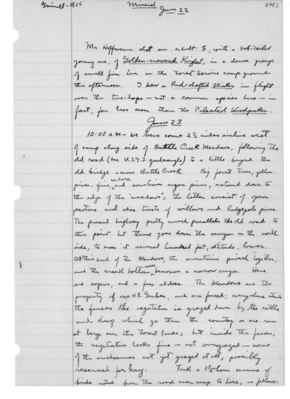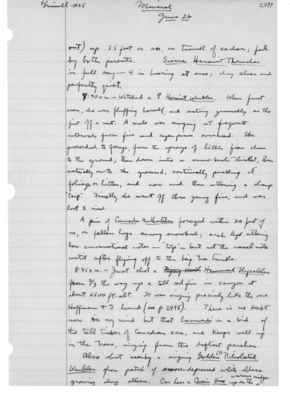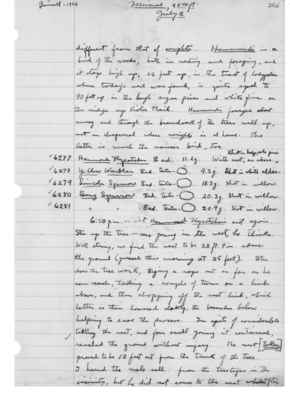Pages That Mention sugar pine
1925: Joseph Grinnell's field notes
S2 Page 34
Collector: Grinnell-1925 Location: Mineral Date: June 22 Page Number: 2489
sitting closely, nearly touched before she flew off. Nest 1750 mm out to south of trunk of cedar, which is a small tree, 8 in. diam., growing beneath sugar pine and white fir. Taken; incubation of eggs ^well begun. (1/4).
8:05 a.m. - Mt. Chickadee's nest, with well-feathered young, in old woodpecker (?) hole in barkless broken-off pine stub 2 ft. in diam.; lower edge of entrance, 1950 mm. above ground. Diam. of entrance 40 mm.; ^38 mm. nest diam.; Both old birds are bringing food to young.
Just followed up a song which puzzled me. The producer would stay ^still, perched 75 to 100 feet up in firs or yellow pines. Sang a sustained, vigorous, dry trill, but dropping toward end. Quietly chipping sparrow like, but this falling at the end made me suspect an orange crowned warbler. The bird, finally seen clearly, was a Chipping Sparrow.
One or more Golden-crowned Kinglets in a clump of young fir. A Solitaire "creaking" in the distance. A Pileated Woodpecker, flying thru the woods, giving its resonant "Kuk" slowly and irregularly in a long series. At least two singing Calaveras Warblers on this dry ridge in vicinity of some smallish black oaks, but singing from all sorts of places, up to 75 feet up in firs and cedars. Tho Ch Calif. Purple Finches in full song nearby.
10:12 a.m. - Solitaire's nest, on level of ground inside a cavity (old burn) in base of ^living sugar pine 2 1/2 feet in diameter. The four young are wholly
S2 Page 36
Collector: Grinnell - 1925 Location: Mineral Date: June 22 Page Number: 2490
sheltered within the cavity, the nest being in-set in bark and needle floor right against the charcoal wall. Rim of nest (exposed side) marked by coarse pine twigs and needles, scattering out towards opening of cavity; latter 600 mm. high at peak, 480 mm. wide at base of opening; rim of nest a little higher, about 25 mm., than ground in front. Nest found by watching old birds, with food perching around quietly on stubs of fallen logs and lower branches of big standing trees, finally flying down to side. The yellow thickened corners of mouth and edges of bill loom up a most conspicuous feature of young in shade of cavity. On dry ridge top, open forest of white fir, cedar, yellow and sugar pines.
Saw a Sharp-shinned Hawk in flight from direction of camp, well above tree-tops. One or both of a pair of Evening Grosbeaks were noted repeatedly in a certain section of the woods. Mr. Hoffmann discovered a Hammond(*) Flycatcher's nest^(5500 ft. alt.) fully 90 ft. up on a horizontal sub-branch of a huge sugar pine - of course inaccessible. The birds looked ^at that range and sounded, to me, indistinguishable from the "Wright" Flycatchers I have been getting down here with low brush-built nests. However, only shooting of the birds can settle their identity. I saw one of Hoffman's birds come clear to the ground and flit about in small firs and low snow-brush; yet both of the birds did a lot of foraging fully 100 feet up, in firs and pines.
S2 Page 38
Collector: Grinnell - 1925 Location: Mineral Date: June 22 Page Number: 2492
Mr. Hoffmann shot an adult male, with a bob-tailed young one, of Golden-crowned Kinglet, in a dense group of small fir here on the Forest Service camp ground this afternoon. I saw a Red-shafted Flicker in flight over the tree-tops - not a common species here - in fact, far less seen than the Pileated Woodpecker.
June 23 10:00 a.m. - we have come 2 1/2 miles airline west of camp along side of Battle Creek Meadows, following the old road (see U.S.G.S quadrangle) to a little beyond the old bridge across Battle Creek. Big forest trees, yellow pines, fir, cedars, and sometimes sugar pines, extend down to the edge of the "meadows"; the latter consist of open pasture and also tracts of willows and lodgepole pines. The present highway pretty much parallels the old road to this point but thence goes down the canyon on the north side, to cross it several hundred feet, altitude, lower. At this end of the Meadows, the mountains pinch together, and the creek bottom ^soon becomes a narrow canyon. Here are aspens, and a few alders. The Meadows are the property of one W. L. Gerber (?), and are fenced; everywhere astride the fences the vegetation is grazed down by the cattle and sheep which go thru [sic] the country or are seen at large over the forest lands; but inside the fences, the vegetation looks fine - not overgrazed - some of the enclosures not yet grazed at all, possibly reserved for hay. Took a 1 1/2 hour census of birds notes from the road near camp to here, as follows:
S2 Page 43
Collector: Grinnell - 1925 Location: Mineral Date: June 26 Page Number: 2497
out) up 35 feet or so, on trunk of cedar; fed by both parents. Sierra Hermit Thrushes in full song - 4 in hearing at once, day clear and perfectly quiet.
7:40 a.m. - Watched a [female symbol] Hermit Warbler. When first seen, she was fluffing herself, and attacking generally as tho just off a nest. A male was singing at frequent intervals from fir and sugar pines overhead. She proceeded to forage, from the sprays of little fir close to the ground; then down into a snow-bush thicket, then actually on to the ground, continually picking at foliage or litter, and now and then uttering a sharp "tsip." Finally she went off thru young firs, and was lost to view.
A pair of Canada Nuthatches foraged within 20 feet of us, on fallen logs among snowbush; each kept uttering low conversational notes "Tiys" - but not the nasal note until after flying off to the big tree trunks.
8:45 a.m. - Just shot a Pygmy Nuth Hammond Flycatcher from 2/3 the way up a all red fir in canyon at about 6500 ft. alt. It was singing precisely like the one Hoffmann & I heard (see p. 2495). There is no doubt now in my mind but that hammondi is a bird of the tall timber of Canadian zone, and keeps well up in trees, singing from the loftiest perches.
Also shot a singing Golden ^(?) Pileolated Warbler from batch of snow-depressed white alders growing along the stream. Can hear a Cassin Vireo up on the ^warmer ridge.
S2 Page 62
Collector: Grinnell - 1925 Location: Mineral, 4800 ft. Date: July 2 Page Number: 2515
different from that of wrighti. Hammondi is a bird of the woods, both in nesting and foraging, and it stays high up; 25 feet up, in the tract of lodgepoles where today's nest was found, is quite equal to 90 feet up in the high sugar pines and white firs on the ridge up Viola Trail. Hammondi forages about among and through the branchwork of the trees well up, not in chaparral where wrighti is at home. The latter is much the noisier bird, too.
6277 Hammond Flycatcher [female symbol] ad. 11.2g. With nest, as above. ^Shot in lodgepole pine. 6278 Yellow Warbler [male symbol] ad. testes [testes illustration]. 9.2g. Shot in white alder. 6279 Lincoln Sparrow [male symbol] ad. testes [testes illustration]. 18.3g. Shot in willow. 6280 Song Sparrow [male symbol] ad. testes [testes illustration]. 20.3g. Shot in willow. 6281 [Song] [Sparrow] [male symbol] ad. testes [testes illustration]. 20.4g. Shot in willow.
6:50 p.m. - At Hammond Flycatcher's nest again. Stu up the tree - sees young in the nest, he thinks. With string, we find the nest to be 28 ft. 9 in. above the ground (guessed this morning at 25 feet). Stu does the tree work, tying a rope out as far as he can reach, taking a couple of turns on a limb above, and then chopping off the nest limb, which latter is then lowered slowly, the branches below helping to ease the process. In spite of considerable tilting the nest, and four small young it contained, reached the ground without injury. The nest [taken] proved to be 13 feet out from the trunk of the tree. I heard the male call from the treetops in the vicinity, but he did not come to the nest while after




